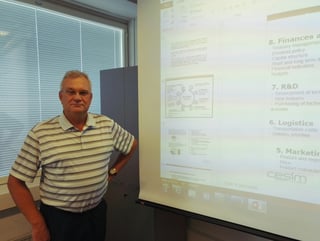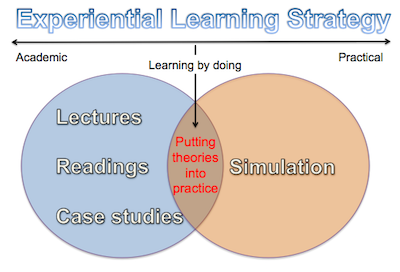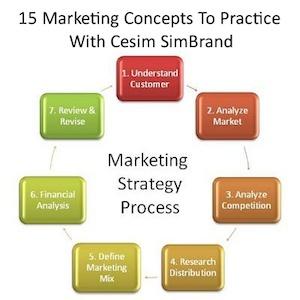 Are business simulations only meant for business students? Apart from our many business school participants, Cesim simulations are also very popular among science, technology, engineering and mathematics (STEM) educational organizations and corporations that aspire to solve the STEM education challenges by enhancing the learning experience and outcomes of their students or employees. Wonder why these institutions choose business simulations as a teaching tool? Read on to find out the simulation experience sharing of two STEM educators from Finland and France.
Are business simulations only meant for business students? Apart from our many business school participants, Cesim simulations are also very popular among science, technology, engineering and mathematics (STEM) educational organizations and corporations that aspire to solve the STEM education challenges by enhancing the learning experience and outcomes of their students or employees. Wonder why these institutions choose business simulations as a teaching tool? Read on to find out the simulation experience sharing of two STEM educators from Finland and France.
How do business simulations as an educational technology help alleviate the challenges in STEM education, improve the teaching effectiveness and learning satisfaction, and prepare students to be career ready? Let's explore the real life examples of two STEM educators from Finland and France and take a look at how they use business simulation games to tackle teaching and learning issues.
 Prior to teaching industrial engineering at Metropolia University of Applied Sciences in Finland a decade ago, Jarmo Toivanen has taught in tertiary institutions in different parts of Europe and in the world. Mr Toivanen also has over twenty years of experience in international companies in various management positions. His areas of expertise include project engineering, computerized design, computer-aided design (CAD), computer aided engineering, as well as the use of computer in teaching, designing and operations. He enjoys contributing to teaching and education development by publishing articles in international journals and writing teaching materials and books. He uses Cesim Global Challenge to innovate the teaching of operations and supply chain management in his courses.
Prior to teaching industrial engineering at Metropolia University of Applied Sciences in Finland a decade ago, Jarmo Toivanen has taught in tertiary institutions in different parts of Europe and in the world. Mr Toivanen also has over twenty years of experience in international companies in various management positions. His areas of expertise include project engineering, computerized design, computer-aided design (CAD), computer aided engineering, as well as the use of computer in teaching, designing and operations. He enjoys contributing to teaching and education development by publishing articles in international journals and writing teaching materials and books. He uses Cesim Global Challenge to innovate the teaching of operations and supply chain management in his courses.
 After a career as a Project Manager at France Telecom and a HR manager at INSA Lyon, Claude Guédat is now a Vice President of the Telecom Department at INSA Lyon, ranking among the top universities of science and technology in Europe. The Department of Telecommunications of INSA Lyon educates engineers with a strong scientific and technical knowledge base in three complementary areas of telecommunications: technologies and transmission media, computer science, and networks. With a strong orientation in "services and uses", a large part of the engineering degree is left to management and soft sciences which represents over 25% of the curriculum with specific modules and social sciences dimension in all projects undertaken by the students. Mr Guédat has been using for several years, two Cesim business games: Cesim SimBrand as an element of the Marketing and Trade Negotiations Module for telecom engineering students, and Cesim OnService as a component of the apprenticeship degree for introduction to business and "team building" of new promotions.
After a career as a Project Manager at France Telecom and a HR manager at INSA Lyon, Claude Guédat is now a Vice President of the Telecom Department at INSA Lyon, ranking among the top universities of science and technology in Europe. The Department of Telecommunications of INSA Lyon educates engineers with a strong scientific and technical knowledge base in three complementary areas of telecommunications: technologies and transmission media, computer science, and networks. With a strong orientation in "services and uses", a large part of the engineering degree is left to management and soft sciences which represents over 25% of the curriculum with specific modules and social sciences dimension in all projects undertaken by the students. Mr Guédat has been using for several years, two Cesim business games: Cesim SimBrand as an element of the Marketing and Trade Negotiations Module for telecom engineering students, and Cesim OnService as a component of the apprenticeship degree for introduction to business and "team building" of new promotions.
Multichannel teaching and learning
A study on college and university students' perspective of STEM courses (Chang and Park, 2014) pointed out that "the effectiveness of teaching is the critical factor that has a great impact on student satisfaction and retention in STEM courses."
The integration of a business simulation brings many benefits, especially because the new generation of students no longer settles for the traditional format of theoretical lectures or paper exercises. This is the major reason why Mr Guédat uses Cesim business simulations as a part of a wider strategy to adopt digital tools to diversify INSA Lyon's teaching methods.
 Mr Toivanen believes that the subjects in industrial engineering are so multifaceted that in order for students to connect and understand phenomenons of what happens in operations management, it is important for instructors to provide students with examples. He continues with his explanation, "We use a lot of examples, those examples are either real world examples that come from experience or from what I have read. It is important that you have different kinds of tools in teaching, so that in addition to giving lectures and using case studies, you also make use of different articles and a wide range of information from academic journals. Finally, you need a tool to create an understanding and convey the meaning of this multiformat teaching to students. Simulation games especially motivate students towards learning, because they have to learn if they want to win and be good in the game, they have to read a lot of information and materials. It is a very powerful teaching tool."
Mr Toivanen believes that the subjects in industrial engineering are so multifaceted that in order for students to connect and understand phenomenons of what happens in operations management, it is important for instructors to provide students with examples. He continues with his explanation, "We use a lot of examples, those examples are either real world examples that come from experience or from what I have read. It is important that you have different kinds of tools in teaching, so that in addition to giving lectures and using case studies, you also make use of different articles and a wide range of information from academic journals. Finally, you need a tool to create an understanding and convey the meaning of this multiformat teaching to students. Simulation games especially motivate students towards learning, because they have to learn if they want to win and be good in the game, they have to read a lot of information and materials. It is a very powerful teaching tool."
Supplemental resources for courses and curriculums
 In order to complement the content of his courses, Mr Toivanen makes use of modules that are available in Cesim Global Challenge. He gave an example on how he teaches finance management with the taxation option, transfer pricing. "You have to teach and you have to explain for students' understanding, what it means in the worldwide trade and in regulations, where the things are from, why do we have to have the system so-called transfer pricing. The other thing is that they need to understand the connectivity of several locations around the world, how the money moves internally, how you use the money internally in investment and get the profit and so on. That kind of things you have to teach."
In order to complement the content of his courses, Mr Toivanen makes use of modules that are available in Cesim Global Challenge. He gave an example on how he teaches finance management with the taxation option, transfer pricing. "You have to teach and you have to explain for students' understanding, what it means in the worldwide trade and in regulations, where the things are from, why do we have to have the system so-called transfer pricing. The other thing is that they need to understand the connectivity of several locations around the world, how the money moves internally, how you use the money internally in investment and get the profit and so on. That kind of things you have to teach."
Further reading on teaching with international tax and the transfer pricing option in Cesim Global Challenge: Irish-Dutch Sandwiches, Corporate Inversions, and Arm’s Length Transactions: International Tax for IB Courses by James Nebus, published in AIB Insights Volume 16 Issue 2.
 Mr Guédat summarized Cesim business simulations as a concrete way to illustrate the theoretical concepts taught in lectures. "Initially, we were surprised by the complexity of the Cesim SimBrand marketing simulation. After the first round, we realized that the problem does not come from the complexity of the simulation platform but rather from the students' level of analysis in terms of business strategy." He continued to describe how Cesim simulations are a well-designed platform, "Even though STEM students have to take into account many parameters and new developments in a limited time and in a context that they are not familiar with: marketing and business strategy, adequate information is provided to enable participants to assimilate the knowledge necessary for the proper understanding of the business game and the use of the platform."
Mr Guédat summarized Cesim business simulations as a concrete way to illustrate the theoretical concepts taught in lectures. "Initially, we were surprised by the complexity of the Cesim SimBrand marketing simulation. After the first round, we realized that the problem does not come from the complexity of the simulation platform but rather from the students' level of analysis in terms of business strategy." He continued to describe how Cesim simulations are a well-designed platform, "Even though STEM students have to take into account many parameters and new developments in a limited time and in a context that they are not familiar with: marketing and business strategy, adequate information is provided to enable participants to assimilate the knowledge necessary for the proper understanding of the business game and the use of the platform."
Further reading on the positive impact of Cesim SimBrand marketing simulation on students in mathematical, quantitative and financial skills: How Much Do Simulation Games Improve Marketing Students’ Numeracy and Financial Skills? by Lynn Vos and Ross Brennan, published in Academy of Marketing 2012.
Another important feature emphasized by Mr Toivanen is how simulations enable students to see an overall picture of the operations management in addition to the theoretical background they learn in the classroom. "When you are dealing with a global company which is manufacturing and selling goods all over the world, there are many factors you need to take into account that makes you think of the big picture of running a big company. The understanding of the connections among different subjects, what students have learned and what we have taught in school, and what the factors are in business and their connections, that’s the most important thing."
Debunking the STEM paradox and closing the skills-based STEM gap
It is indicated by Meghan Groome, Executive Director of Education and Public Program at New York Academy of Sciences, that the universal STEM education challenge lies in the lack of soft skills training among STEM students due to rote memorization that is brought forth by standardized testing.
Mr Guédat believes that Cesim simulations offer exactly that golden opportunity to develop STEM students' people skills by improving their teamwork skills and critical thinking ability. Competing in teams against each other instead of against the computer creates a lot of enthusiasm in Cesim simulations, "All participants are interested in the evolution of the business strategy game, and often people from two different groups, so two different worlds, help each other and exchange information on their respective universe. Because of the opposition of ideas and reasoned discussions, students have a rewarding experience in developing a more comprehensive marketing approach and a real learning outcome of their decisions."
Mr Toivanen accounts for how his engineering students learn about project management, time management, and group work skills, "After they realize that this is not just a game, that they realize how easy it is for them to make mistakes and lose the competition, they become quite ambitious. I think, in many cases, when the teams are working very well, it is quite a good place for students to learn team work and responsibilities. Because students have to adhere to the tight schedules in the simulation game and complete their tasks and strategies before deadlines. There are quite a lot of things for them to do before confirming their decision as a team."
The joy of learning
The highlights of the game are the commitment to learn and illustration in real time for Mr Guédat. "We have evidences that the playful and competitive aspects of the simulation strengthen students' motivation and engagement. We find that the strategic side brings a lot to students' concentration and involvement in understanding and using marketing concepts. To summarize the use of this 'serious game', we can say that we have totally fallen for it. The simulation game is very well designed and allows participants to learn real world marketing and strategy concepts on a fun and enjoyable platform. Being able to get into the skin of an IT or software company on the market allows students to understand how difficult it is to make the right decisions at the right time."
Mr Toivanen thinks that students should learn to have fun and enjoy what they will possibly be doing in their future work and the same should apply to studying, "While students are playing the simulation rounds, they start to understand the development and comprehend the interconnectivity among what they have been learning all the time. Students start to enjoy learning as they become interested in making efforts to design the brand of the simulated company that they are running, from formulating strategies on paper to executing the business plan in the simulation game. They have to build the brand by considering all relevant aspects, they have to go in-depth of what they are doing, that they are running a business which has a brand. Not only is the simulation an interesting learning tool, it also has an enormous possibility to develop your teaching, so use the simulation to connect the substance and the phenomenons in operations management and empower students to understand the different factors and their connectivity."
Are you ready to discover experiential learning with us to enhance students' learning outcomes?


